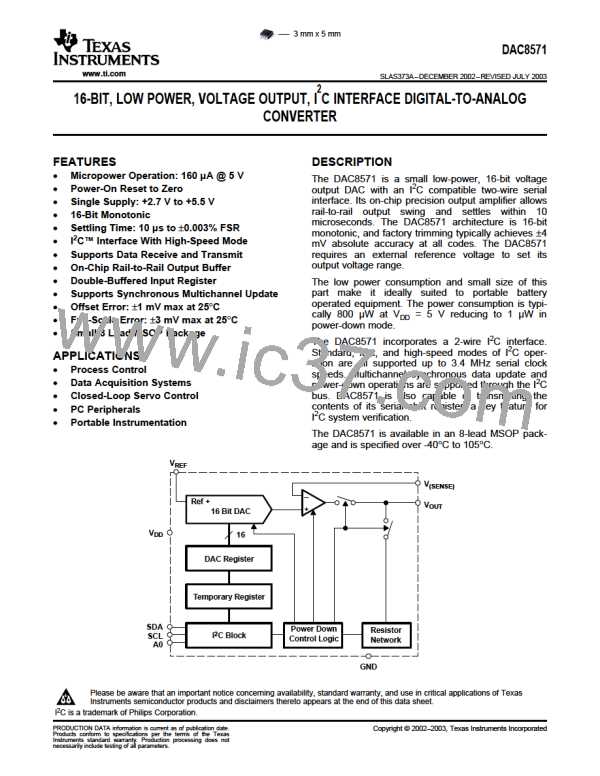DAC8571
www.ti.com
SLAS373A–DECEMBER 2002–REVISED JULY 2003
Master Receiver Reading From a Slave Transmitter (High-Speed Mode)
I2C protocol starts when the bus is idle, that is, when SDA and SCL lines are stable high. The master then pulls
the SDA line low while SCL is still high indicating that serial data transfer has started. This is called a start
condition, and can only be asserted by the master. After the start condition, the master device puts out the
high-speed master code 0000 1xxx. No device is allowed to acknowledge the master code, but the devices are
required to switch their internal settings to support 3.4 Mbps operation upon the receipt of this code. After the
not-acknowledge signal, the master is allowed to operate at high speed. Now at much higher speed, the master
generates a repeated start condition. After the start condition, the master generates the serial clock pulses and
puts out an address byte, ADDRESS<7:0>. While generating the bit stream, the master ensures the timing for
valid data. For each valid I2C bit, SDA line should remain stable during the entire high period of the SCL line. The
address byte consists of seven address bits and a direction bit (R/W=1). After sending the address byte, the
master generates a 9th SCL pulse and monitors the state of the SDA line during the high period of this 9th clock
cycle (master leaves the SDA line high). The SDA line being pulled low by the receiver during the high period of
9th clock cycle is called an acknowledge signal. If the master receives an acknowledge signal, it knows that a
DAC8571 successfully matched the address the master sent. Since the R/W bit in the address byte was set,
master also knows that DAC8571 is ready to transmit data. Upon the receipt of this acknowledge, the master
knows that the communication link with a DAC8571 has been established and more data could be received. The
master continues by sending eight clock cycles during which DAC8571 transmits an M<7:0>. If the master
detects all bits of the M<7:0> as valid data, it sends an acknowledge signal in the 9th cycle. DAC8571 detects
this acknowledge signal and prepares to send more data. Upon the receipt of eight more clock cycles from the
master, DAC8571 transmits L<7:0>. If the master detects all bits of the L<7:0> as valid data, it sends an
acknowledge signal to DAC8571 during the 9th clock cycle. DAC8571 detects this acknowledge signal and
prepares to send more data. Upon the receipt of eight more clock cycles from the master, DAC8571 transmits
the control byte, C<7:0>. In the 9th clock cycle the master transmits a not-acknowledge signal to DAC8571 and
terminates the sequence with a stop condition, by pulling the SDA line from low to high while clock is high.
M<7:0> and L<7:0> data could be either DAC data or could be the data stored in the temporary register. Bits in
the C<7:0> reveal this information. A stop condition during the high-speed mode also indicates the end of the
high-speed mode. Table 4 demonstrates the sequence of events that should occur while a master receiver is
reading from DAC8571 in I2C high-speed mode.
Table 4. Master Receiver Reads Data From Slave Transmitter in High-Speed Mode
HS Mode Read Sequence-Data Transmit
Transmitter
Master
MSB
6
5
4
3
2
1
LSB
Comment
Start
Begin sequence
HS Mode master code
Master
0
0
0
0
1
X
X
X
No device may acknowledge HS
master code
NONE
Not Acknowledge
Repeated Start
Master
Master
1
0
0
1
1
A0
D10
D2
0
R/W
D8
Read addressing (R/W=1)
High byte
DAC8571
DAC8571
Master
DAC8571 Acknowledges
D12 D11
Master Acknowledges
D4 D3
Master Acknowledges
C4 C3
D15
D7
C7
D14
D6
C6
D13
D5
C5
D9
D1
C1
DAC8571
Master
D0
Low byte
DAC8571
Master
C2
C0
Control byte
Master Not Acknowledges
Stop or Repeated Start(1)
Master signal end of read
Done
Master
(1) Use repeated start to secure bus operation and loop back to the stage of write addressing for next Write.
18

 TI [ TEXAS INSTRUMENTS ]
TI [ TEXAS INSTRUMENTS ]